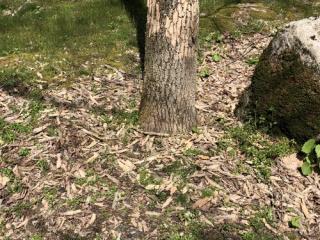An Epidemic Among Trees

You may have noticed an unusually large number of very tall dead trees with pale trunks in Tuxedo Park and in the surrounding areas. These are Ash trees, a ubiquitous native that is being devastated by the Emerald Ash Borer (EAB).
EAB is an exotic beetle that was discovered in the US only in 2002 that has quickly spread from Michigan to the Northeast. While adult beetles nibbling on Ash foliage cause little damage, the larvae (the immature stage) feeding on the inner bark strangle the tree by disrupting its ability to transport water and nutrients. The trunks of dying or dead Ash trees turn light brown – this is called “blonding” – when the woodpecker has picked off the bark in search of the delicious larvae.
While some treatments are available from licensed arborists to help save a still healthy Ash, they involve chemicals that should best not be introduced into the environment and are too expensive to be applied on any scale. This makes removal – and replanting – of the diseased trees the most practiced solution, costing billions of dollars nationwide.
To slow the spread of EAB, the cut timber of a dead or infested Ash should not be transported for more than 50 miles.
Consider replanting with native trees such as oak, dogwood, red bud, sugar maple. Not only are they beautiful, they also provide shelter and food to birds and other wildlife. Importantly, the root system helps prevent property damage from soil erosion and water runoff. Native trees are suited to the local environment – but don’t plant near or under the electric and cable lines or Orange & Rockland will eventually have to top them!
